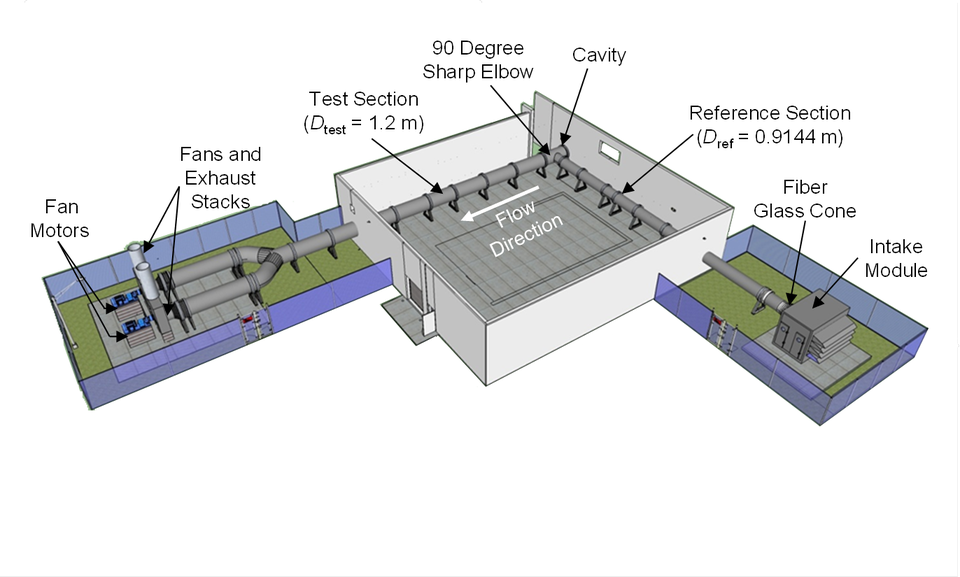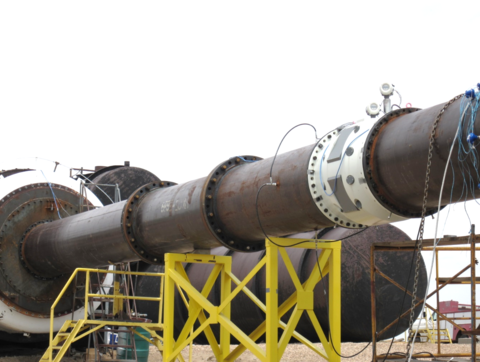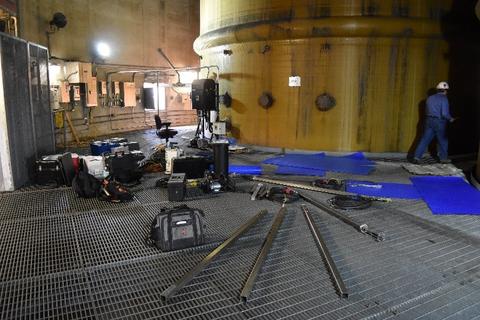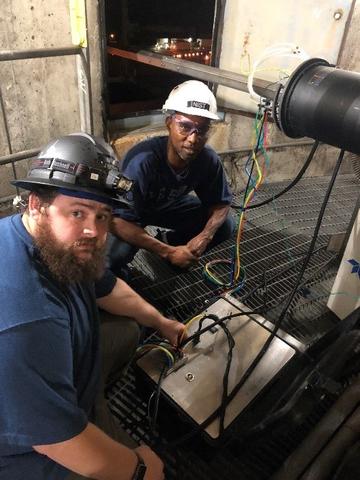Summary
Presently used methods to measure CO2 and other emissions from smoke stacks have errors of 20 % or more depending on the level of swirl in the flow. The objective of this project is to measure stack emissions with an uncertainty on the order of 1% at a reasonable cost. [1, 2, 3]
NIST and power industry partners represented by the Electric Power Research Institute (EPRI) are using the NIST smoke stack simulator and field tests at power plant stacks to show that NIST designed sensors and methods reliably attain 2 % uncertainty, regardless of the swirl level in the flow. NIST smoke stack profiling methods and sensors are resistant to plugging by solids and water in smoke stacks, are 4x faster, and are 10x more accurate than presently used methods.
Description
The Fluid Metrology Group is using its smoke stack simulator (See Fig. 1.) and field tests in operating smoke stacks to critically test conventional and improved ways of measuring the flow of stack gases.

In the NIST stack simulator, the inlet cone and reference (upstream) section of the simulator draw in ambient (outside) air and generate a swirl-free, fully-developed turbulent flow. The reference section features an 8-path ultrasonic flow meter that NIST calibrated with an uncertainty of 0.8% (at a 95% confidence level) while it was installed in the same inlet and outlet pipes.

Figure 1 shows a tee connecting the reference section to the downstream test section. (One leg of the tee is a small "dead" volume.) The tee generates counter-rotating vortices in the test section, thereby simulating the flow generated by a typical connection between a power plant's pollution control system and its stack. Obstacles (such as perforated plates) can be inserted in the test section to further complicate the flow. The exhaust fans generate flow velocities typical of power-plant stacks (6 m/s to 25 m/s) in the 28 m-long test section which has a diameter of 1.2 m (4 ft).
The smoke stack simulator generates known (±0.8 %) flows for evaluating:
- flow meters installed in smoke stacks for EPA-approved Continuous Emission Monitoring Systems (CEMS), usually transit-time ultrasonic flow meters and,
- the profiling methods used to periodically calibrate the CEMS. The profiling methods position airspeed sensors at prescribed positions across the stack and integrate them to obtain the bulk flow. These Relative Accuracy Test Audits (RATAs) follow EPA protocols and use differential pressure pitot sensors called S-probes or 3-D probes.


Improved profiling methods and sensors:
NIST and industrial collaborators developed new methods (e.g. the NIST non-nulling or NNN method) that are faster, more accurate, and easier to apply than the presently used methods. The NNN method and new probe designs have been tested in the NIST wind tunnel, the Smoke Stack Simulator, and in multiple field tests at power plants. The stack simulator is preferable for assessing the accuracy of the NNN method because it has a low uncertainty reference (0.65 %). Field tests are essential for demonstrating the practicality, robustness, and time efficiency of the NNN method.
Stack simulator results:
- The NIST Non-Nulling method using a spherical probe agreed with the smoke-stack simulator flow reference within 1 %.
- These results were obtained for yaw angles of almost 40°, a practical maximum value for stack flows.
- NIST researchers demonstrated that X-pattern ultrasonic CEMS provide excellent compensation for swirl. In the stack simulator the X-pattern reduced errors of a single path measurement from 17 % to 1 %. Load dependent errors in the calibrated single path CEMS were reduced from 3% to less than 0.5 %. Similar trends were observed in field stack tests.
Field test results:
- Researchers used a spherical probe (corrected for imperfect yaw-nulling) as the flow reference for field work. Prior work shows 1 % uncertainty can be expected for this method.
- The NIST Non-Nulling method using a spherical probe agreed with the reference method within 1 %.
- The NIST Non-Nulling method can measure 4x faster than an S-probe (Method 2G) and 5x faster than a spherical probe (Method 2F).
- Enlarged pressure ports in the NIST-designed sensors showed no problems due to pressure port plugging. NIST developed diagnostics for detecting port plugging.
- The speed of the NNN method enables a denser sampling of stack cross-section velocities, which in turn, improves measurement accuracy.
Conclusion:
NIST stack profiling methods and sensors do not suffer from plugging, are 4x faster, and are 10x more accurate than presently used methods. Presently used methods have errors of 20 % or more depending on the level of swirl while the new method will reliably attain 2 % uncertainty, regardless of the swirl level. Ongoing work on sensor calibration will reduce the NNN uncertainty to 1 %, a 20x improvement over the presently used method.
We are also exploring alternative methods of measuring flue gas flows such as:
- long-wavelength acoustic flow meter
- injecting tracers and measuring their dilution

